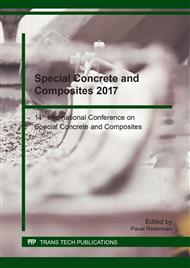p.16
p.22
p.30
p.37
p.43
p.49
p.55
p.61
p.67
Retarding Action of Various Lead (II) Salts on Setting of Portland Cement
Abstract:
Lead is an example of heavy metal, which influences the course of silicate cement hydration resulting to retardation of setting and hardening. This topic become of importance when a cementitious material is intended to be used as solidification/stabilization matrix for a waste or secondary product containing some lead species. There are literature data on the effect of Pb retarding action but they are incomparable each other due to uneven experimental conditions, used Pb salts, types of cement etc. The present paper aims to describe influence of various lead(II) compounds (nitrate, sulfate and lead(II) oxide) on setting course of Ordinary Portland cement (OPC). The setting was monitored by Vicat apparatus, the dosage of salts (expressed as wt. % of elementary Pb to OPC) was 0.5, 1, 2 and 5%. Obviously the present anions may also influence the setting time; the set of control experiments with sodium salts of above given anions was performed in order to eliminate the anion effect. The PbO was found to be most detrimental towards retarding of setting, while lead sulfate at higher dosages caused high instability of setting (oscillation). The effect of Pb was, in all cases, more important than influence of given anion.
Info:
Periodical:
Pages:
43-48
Citation:
Online since:
January 2018
Authors:
Keywords:
Price:
Сopyright:
© 2018 Trans Tech Publications Ltd. All Rights Reserved
Share:
Citation:


